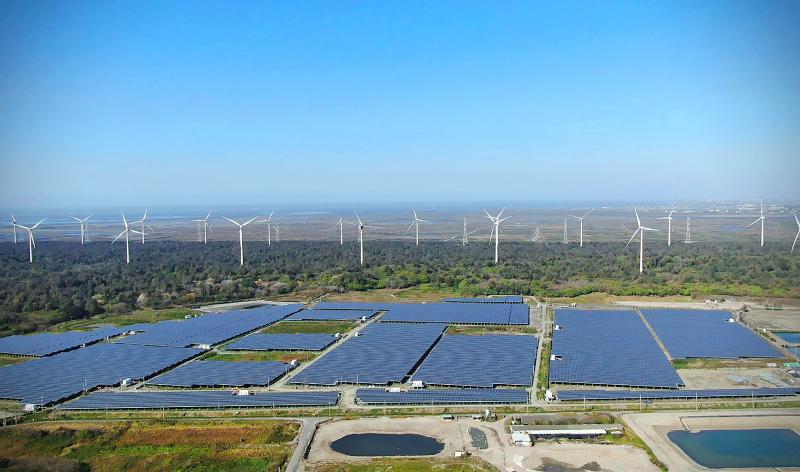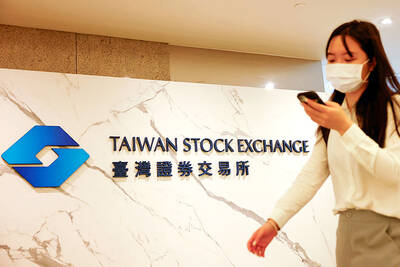Cathay Life Insurance Co (國泰人壽) aims to double its cumulative investment in domestic solar power projects to at least NT$20 billion (US$716.8 million) by 2025, as the green energy business yields high rates of return and growing the sector is good for the environment, Cathay Life president Liu Shan-chi (劉上旗) said on Saturday.
The life insurer has invested NT$10 billion in 250 local photovoltaic farms, including rooftop, ground-mounted and floating solar systems, with a combined capacity of 200 megawatts (MW).
The company plans to seek more projects in coming years, boosting the overall capacity of the photovoltaic farms it invests in to 400MW or more by the end of 2025, Liu said.

Photo courtesy of Cathay Financial Holding Co via CNA
Given that the average construction cost for solar power projects stands at NT$50 million per megawatt of capacity, Cathay Life’s cumulative solar investment is expected to total at least NT$20 billion by 2025, he said.
On Saturday, the life insurer launched a NT$5 billion ground-mounted solar power station in Yunlin County’s Mailiao Township (麥寮).
Cathay Life is partnering with Solar Master Energy Co Ltd (開陽能源) and San Ching Engineering Co (三井工程) to invest in the station, which has a targeted capacity of 100MW.
The three firms formed a joint venture, CM Energy Co Ltd (開泰能源), with paid-in capital of NT$1 billion. Cathay Life holds a 45 percent stake, and Solar Master and San Ching hold 30 percent and 25 percent stakes respectively, Liu said.
The life insurer said that the station has a capacity of 26MW and has been connected to Taiwan Power Co’s (台電) grid since March.
The station plans to build up the remaining capacity from next year, it added.
As the station is situated in an area affected by land subsidence — gradual sinking or settling — it took the companies five years to finish preliminary work, such as negotiating with land owners and completing land leveling and piling. Solar Master said that 9m piles and anti-corrosion coating have been used in the project due to its special topography.
Although building photovoltaic systems in areas affected by land subsidence costs about NT$60,000 per kilowatt, higher than for regular projects, the station is expected to yield an internal rate of return of between 4.5 and 5 percent, higher than a return of less than 3 percent for the life insurer’s investment in real estate, it said.
Asked whether solar power could be sold to companies in the private sector, Solar Master chairman Tsai Tsung-jung (蔡宗融) said chances would be slim, as the partners signed a contract with Taipower in 2018 to sell power for about NT$5 per unit.
As the government has cut the feed-in tariff rates for solar energy since 2018, power is more likely to be purchased from other photovoltaic projects at cheaper rates, Tsai said.
Cathay Life has established Cathay Power Inc (國泰電業) to focus on green energy investment, making it the nation’s first life insurer to create a utility-related subsidiary.

ADVANCED: Previously, Taiwanese chip companies were restricted from building overseas fabs with technology less than two generations behind domestic factories Taiwan Semiconductor Manufacturing Co (TSMC, 台積電), a major chip supplier to Nvidia Corp, would no longer be restricted from investing in next-generation 2-nanometer chip production in the US, the Ministry of Economic Affairs said yesterday. However, the ministry added that the world’s biggest contract chipmaker would not be making any reckless decisions, given the weight of its up to US$30 billion investment. To safeguard Taiwan’s chip technology advantages, the government has barred local chipmakers from making chips using more advanced technologies at their overseas factories, in China particularly. Chipmakers were previously only allowed to produce chips using less advanced technologies, specifically

The New Taiwan dollar is on the verge of overtaking the yuan as Asia’s best carry-trade target given its lower risk of interest-rate and currency volatility. A strategy of borrowing the New Taiwan dollar to invest in higher-yielding alternatives has generated the second-highest return over the past month among Asian currencies behind the yuan, based on the Sharpe ratio that measures risk-adjusted relative returns. The New Taiwan dollar may soon replace its Chinese peer as the region’s favored carry trade tool, analysts say, citing Beijing’s efforts to support the yuan that can create wild swings in borrowing costs. In contrast,

BRAVE NEW WORLD: Nvidia believes that AI would fuel a new industrial revolution and would ‘do whatever we can’ to guide US AI policy, CEO Jensen Huang said Nvidia Corp cofounder and chief executive officer Jensen Huang (黃仁勳) on Tuesday said he is ready to meet US president-elect Donald Trump and offer his help to the incoming administration. “I’d be delighted to go see him and congratulate him, and do whatever we can to make this administration succeed,” Huang said in an interview with Bloomberg Television, adding that he has not been invited to visit Trump’s home base at Mar-a-Lago in Florida yet. As head of the world’s most valuable chipmaker, Huang has an opportunity to help steer the administration’s artificial intelligence (AI) policy at a moment of rapid change.

TARIFF SURGE: The strong performance could be attributed to the growing artificial intelligence device market and mass orders ahead of potential US tariffs, analysts said The combined revenue of companies listed on the Taiwan Stock Exchange and the Taipei Exchange for the whole of last year totaled NT$44.66 trillion (US$1.35 trillion), up 12.8 percent year-on-year and hit a record high, data compiled by investment consulting firm CMoney showed on Saturday. The result came after listed firms reported a 23.92 percent annual increase in combined revenue for last month at NT$4.1 trillion, the second-highest for the month of December on record, and posted a 15.63 percent rise in combined revenue for the December quarter at NT$12.25 billion, the highest quarterly figure ever, the data showed. Analysts attributed the